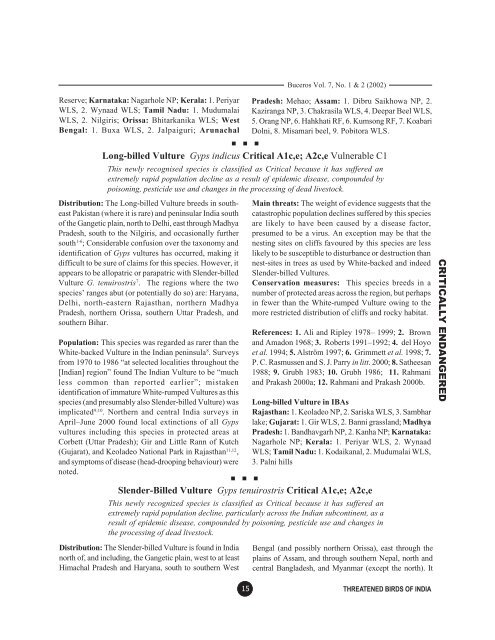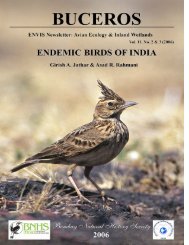Untitled - ENVIS Centre on Avian Ecology
Untitled - ENVIS Centre on Avian Ecology
Untitled - ENVIS Centre on Avian Ecology
Create successful ePaper yourself
Turn your PDF publications into a flip-book with our unique Google optimized e-Paper software.
Reserve; Karnataka: Nagarhole NP; Kerala: 1. Periyar<br />
WLS, 2. Wynaad WLS; Tamil Nadu: 1. Mudumalai<br />
WLS, 2. Nilgiris; Orissa: Bhitarkanika WLS; West<br />
Bengal: 1. Buxa WLS, 2. Jalpaiguri; Arunachal<br />
Buceros Vol. 7, No. 1 & 2 (2002)<br />
Pradesh: Mehao; Assam: 1. Dibru Saikhowa NP, 2.<br />
Kaziranga NP, 3. Chakrasila WLS, 4. Deepar Beel WLS,<br />
5. Orang NP, 6. Hahkhati RF, 6. Kums<strong>on</strong>g RF, 7. Koabari<br />
Dolni, 8. Misamari beel, 9. Pobitora WLS.<br />
L<strong>on</strong>g-billed Vulture Gyps indicus Critical A1c,e; A2c,e Vulnerable C1<br />
Distributi<strong>on</strong>: The L<strong>on</strong>g-billed Vulture breeds in southeast<br />
Pakistan (where it is rare) and peninsular India south<br />
of the Gangetic plain, north to Delhi, east through Madhya<br />
Pradesh, south to the Nilgiris, and occasi<strong>on</strong>ally further<br />
south 1-6 ; C<strong>on</strong>siderable c<strong>on</strong>fusi<strong>on</strong> over the tax<strong>on</strong>omy and<br />
identificati<strong>on</strong> of Gyps vultures has occurred, making it<br />
difficult to be sure of claims for this species. However, it<br />
appears to be allopatric or parapatric with Slender-billed<br />
Vulture G. tenuirostris 7 . The regi<strong>on</strong>s where the two<br />
species’ ranges abut (or potentially do so) are: Haryana,<br />
Delhi, north-eastern Rajasthan, northern Madhya<br />
Pradesh, northern Orissa, southern Uttar Pradesh, and<br />
southern Bihar.<br />
Populati<strong>on</strong>: This species was regarded as rarer than the<br />
White-backed Vulture in the Indian peninsula8 . Surveys<br />
from 1970 to 1986 “at selected localities throughout the<br />
[Indian] regi<strong>on</strong>” found The Indian Vulture to be “much<br />
less comm<strong>on</strong> than reported earlier”; mistaken<br />
identificati<strong>on</strong> of immature White-rumped Vultures as this<br />
species (and presumably also Slender-billed Vulture) was<br />
implicated9,10 . Northern and central India surveys in<br />
April–June 2000 found local extincti<strong>on</strong>s of all Gyps<br />
vultures including this species in protected areas at<br />
Corbett (Uttar Pradesh); Gir and Little Rann of Kutch<br />
(Gujarat), and Keoladeo Nati<strong>on</strong>al Park in Rajasthan11,12 ,<br />
and symptoms of disease (head-drooping behaviour) were<br />
noted.<br />
n n n<br />
This newly recognised species is classified as Critical because it has suffered an<br />
extremely rapid populati<strong>on</strong> decline as a result of epidemic disease, compounded by<br />
pois<strong>on</strong>ing, pesticide use and changes in the processing of dead livestock.<br />
Main threats: The weight of evidence suggests that the<br />
catastrophic populati<strong>on</strong> declines suffered by this species<br />
are likely to have been caused by a disease factor,<br />
presumed to be a virus. An excepti<strong>on</strong> may be that the<br />
nesting sites <strong>on</strong> cliffs favoured by this species are less<br />
likely to be susceptible to disturbance or destructi<strong>on</strong> than<br />
nest-sites in trees as used by White-backed and indeed<br />
Slender-billed Vultures.<br />
C<strong>on</strong>servati<strong>on</strong> measures: This species breeds in a<br />
number of protected areas across the regi<strong>on</strong>, but perhaps<br />
in fewer than the White-rumped Vulture owing to the<br />
more restricted distributi<strong>on</strong> of cliffs and rocky habitat.<br />
References: 1. Ali and Ripley 1978– 1999; 2. Brown<br />
and Amad<strong>on</strong> 1968; 3. Roberts 1991–1992; 4. del Hoyo<br />
et al. 1994; 5. Alström 1997; 6. Grimmett et al. 1998; 7.<br />
P. C. Rasmussen and S. J. Parry in litt. 2000; 8. Satheesan<br />
1988; 9. Grubh 1983; 10. Grubh 1986; 11. Rahmani<br />
and Prakash 2000a; 12. Rahmani and Prakash 2000b.<br />
L<strong>on</strong>g-billed Vulture in IBAs<br />
Rajasthan: 1. Keoladeo NP, 2. Sariska WLS, 3. Sambhar<br />
lake; Gujarat: 1. Gir WLS, 2. Banni grassland; Madhya<br />
Pradesh: 1. Bandhavgarh NP, 2. Kanha NP; Karnataka:<br />
Nagarhole NP; Kerala: 1. Periyar WLS, 2. Wynaad<br />
WLS; Tamil Nadu: 1. Kodaikanal, 2. Mudumalai WLS,<br />
3. Palni hills<br />
Slender-Billed Vulture Gyps tenuirostris Critical A1c,e; A2c,e<br />
Distributi<strong>on</strong>: The Slender-billed Vulture is found in India<br />
north of, and including, the Gangetic plain, west to at least<br />
Himachal Pradesh and Haryana, south to southern West<br />
n n n<br />
This newly recognized species is classified as Critical because it has suffered an<br />
extremely rapid populati<strong>on</strong> decline, particularly across the Indian subc<strong>on</strong>tinent, as a<br />
result of epidemic disease, compounded by pois<strong>on</strong>ing, pesticide use and changes in<br />
the processing of dead livestock.<br />
Bengal (and possibly northern Orissa), east through the<br />
plains of Assam, and through southern Nepal, north and<br />
central Bangladesh, and Myanmar (except the north). It<br />
15 THREATENED BIRDS OF INDIA<br />
CRITICALLY ENDANGERED




